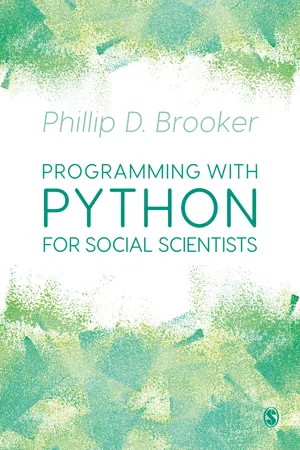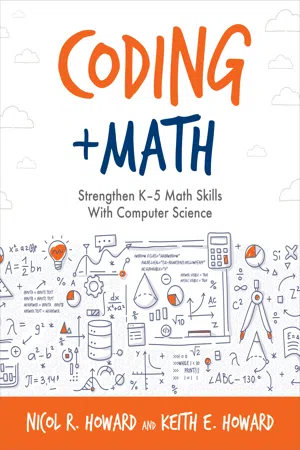if else in Python
In Python, the "if else" statement is used to create conditional logic. It allows the program to execute different blocks of code based on whether a specified condition is true or false. If the condition is true, the code within the "if" block is executed; otherwise, the code within the "else" block is executed. This provides a way to control the flow of the program based on specific conditions.
4 Key excerpts on "if else in Python"
- eBook - ePub
- Phillip D. Brooker(Author)
- 2019(Publication Date)
- SAGE Publications Ltd(Publisher)
...the most difficult to satisfy) condition is checked first. And, in a more general sense, pay attention to the order of your conditions – odd things can happen when you don’t! IF/ELIF/ELSE in action IF, ELIF and ELSE statements are a crucial part of programming in Python and can be used in lots of different ways. As we’ve seen, they can control the values that are assigned to variables, but they can also be used as “flow control” statements which tell your program to do different things depending on the conditions you establish (and more). We’ll see examples of both of these things below, but one key thing to remember is that the structure of your IF/ELIF/ELSE statements is critical to how they operate. As noted, code runs from line 1 down to the bottom of a script, so the sequential order of your lines of code becomes important here – it’s generally a good idea to plan out the logic of your IF/ELIF/ELSE statements before writing the code, so as to prevent against building these kinds of “bugs” into your program. Controlling the flow of the program (and planning code with “pseudocode”). Sometimes programs will have lots of bits of code which do lots of different things, but you may not want to just run the code from line 1 to the end each time. Hence, using IF/ELIF/ELSE statements as a way to control the flow of your program (in conjunction with “functions”, which you will learn about later in the book), you can tell Python which jobs you want to perform and which to bypass. For instance, suppose you want to do some web scraping on a particular webpage – perhaps you want to look at an influential political commentary blog, and scrape once a day for any new content that might have been posted. So, you already have some metadata – the date of the last time you attempted to scrape the blog, and the dataset of blog content you have already scraped (sorted by date)...
- Yasha Hasija, Rajkumar Chakraborty(Authors)
- 2021(Publication Date)
- CRC Press(Publisher)
...In this case, we have to use “if” and “else” statements. 1. The “if” statement is used to execute a block of code if the specified condition is true. 2. The “else” statement is used with an “if” statement to execute a block of code if the specified condition is false. Blocks are defined in Python by indentations after a colon in the statement above it. Indentation is a strict syntax of Python for building a block of the statement, which will often be encountered here. Figure 2.6 is a diagrammatic representation of an “if” statement with a condition and then a colon followed by the indented block of statements to be executed if the condition is true. Figure 2.6 Syntax of an “If” Statement. Let us study an example of comparing the expression of a gene in a controlled and treated environment below: Code: #if condition: # Statements to be executed if the condition is true control_expression = 2.6 treated_expression = 3.5 if control_expression < treated_expression: print(‘Gene is upregulated’) Output: Gene is upregulated Now, we shall learn about an example comparing the expression of a gene in a controlled and treated environment with “If” and “else” statements. Code: #if (condition): # Executes this block if condition is true #else: # Executes this block if condition is false control_expression = 2.6 treated_expression = 3.5 if control_expression > treated_expression: print('Gene is downregulated') else: print('Gene is upregulated') Output: Gene is upregulated We can also insert “if” conditions within a block of an “if” statement for a problem involving multiple condition testing...
- eBook - ePub
Bioinformatics Algorithms
Design and Implementation in Python
- Miguel Rocha, Pedro G. Ferreira(Authors)
- 2018(Publication Date)
- Academic Press(Publisher)
...The simplest case occurs when two different alternatives arise depending on the value of a condition, being represented by the pseudo-code below: In this case, the statements of the first block (below the if) are executed when the condition is true, while the statements in the second block (below the else) are executed otherwise. Note that the else block may not exist if there are no statements to execute if the condition is false. If there are more than two alternative blocks of code, several elif (with the meaning else if) branches may exist with additional logical conditions, while a single final else clause exists, for the case when all previous conditions fail. The pseudo-code below represents the case with multiple conditions: A condition can be either a Boolean variable, a function or operator returning a Boolean result or an expression including those. A common case is the use of comparison operators, presented above in Section 2.2.5. An example of Python code where the score of an exam is tested in a cascade of if / elif / else statements is provided next: A more compact notation to test the logical value of a numerical variable can be used, by including only the name of the variable in the test condition: if var. The first test will hold true, if var is different from zero. Also, a variable with value None always holds false. As an additional example, let us define and test a function to calculate the largest numerical value between two inputs. 2.3.4 Conditional Loops If a statement needs to be executed multiple times (zero or more times) depending on a test condition holding true, the use of a while statement can be appropriate. The pseudo-code of the block of statements within a while cycle is the following: In this case, the statements in the block will be executed while the condition holds true. When the condition switches to false, the loop ends, and the program flow follows with the next statement...
- eBook - ePub
Coding + Math
Strengthen K–5 Math Skills With Computer Science
- Nicol R. Howard(Author)
- 2020(Publication Date)
...Example one is the simplest of the if statements, and it would only run the code between the curly braces if the condition evaluated to true; otherwise, the program would just continue to the next code below it. Example two runs the code below the if statement if the condition is true, but runs the code below the else statement if the condition is false. In example three, if condition one is true, the program will run the code under the if statement; if not, it will test for condition two, and if true, it will run the code under the else-if statement. If neither condition one nor condition two are true, it will run the code under else. Note that one and only one of the code blocks will be executed. Finally, example four adds multiple else-if statements and operates the same way as the previous example, as only one of the four code blocks will be executed. You can string together as many else-if statements as you like, each with its own condition. Learning how to use these statements, particularly in the context of programming toward a particular outcome, goes a long way in developing students’ ability to sequence and to apply logic to scenarios with predictable outcome options. Math learning is strengthened when the Boolean statements used in the conditions are based upon mathematical equations being evaluated as true or false. With this approach, the math is no longer arbitrary (as it may sometimes seem in common math exercises), but is essential to achieving a specific programming goal. Given the accepted and expected process of debugging that is part of the programming culture, learners can test their answers by running their program without any evaluation-based affect involved...



